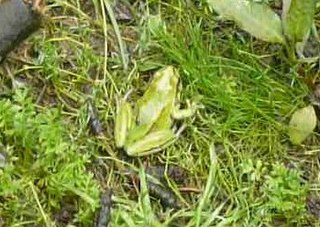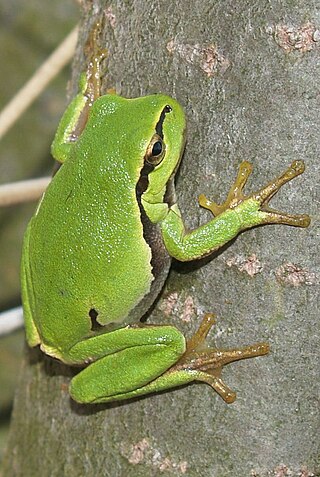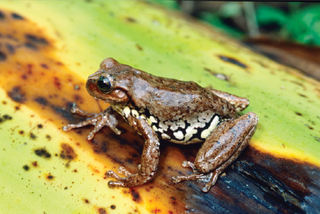
Ptychohyla is a genus of frogs in the family Hylidae. These frogs are found in the southern Mexican states of Chiapas, Guerrero, and Oaxaca, and Central America to western Panama.

Charadrahyla is a genus of frogs in the family Hylidae. It is endemic to tropical southern Mexico. The generic name was derived from Greek charadra ("ravine") and Hyla, in reference to the habits of these frogs. Accordingly, common name ravine treefrogs has been coined for the genus.
Megastomatohyla is a genus of frogs in the family Hylidae. They are endemic to the cloud forests of central Veracruz and Oaxaca, Mexico. All are rare species with restricted distributions. The generic name is derived from Greek mega (="large") and stem of the genitive stomatos (="mouth"), referring to the enlarged oral disc of the tadpoles, juxtaposed with Hyla, the genus in which the four Megastomatohyla species were previously placed. Common name large-mouthed treefrogs has been coined for this genus.

Morelet's tree frog, also known as black-eyed leaf frog and popeye hyla, is a species of frog in the subfamily Phyllomedusinae. It is found in Belize, El Salvador, Guatemala, Honduras, and Mexico.

The ridged tree frog is a species of frog in the family Hylidae endemic to Mexico. Its natural habitats include mountainous pine-fir forests in high elevations. In lower elevations it is known to inhabit moderate and low-lying streams and ponds where it is believed to breed.

Sarcohyla bistincta, also known as the Mexican fringe-limbed treefrog or Cope's streamside treefrog, is a species of frog in the family Hylidae. It is endemic to Mexico; it is widespread and occurs from southern Sinaloa and Durango southeastward to Veracruz and Oaxaca. The nominal Sarcohyla bistincta consists of several lineages that may eventually be described as distinct species.

Sarcohyla labeculata is a species of frog in the family Hylidae. It is endemic to the Sierra Mixe in Oaxaca, Mexico. This species was resurrected from synonymy of Sarcohyla bistincta in 2018, while at the same time bringing Sarcohyla calthula and Sarcohyla ephemera in its synonymy. Common name Mixe streamside treefrog has been proposed for this species, whereas the common names yellow-robed treefrog and Cerro Las Flores spikethumb frog referred to the former S. calthula and S. ephemera, respectively.
Sarcohyla celata, also known as the Oaxaca treefrog, is a species of frog in the family Hylidae. It is endemic to Mexico and only known from the Sierra de Juárez in northern Oaxaca. After having not been seen after 1984, it was feared that the species might be extinct. However, the species was rediscovered in field surveys during 2011–2014 and some subpopulations are at healthy levels.
Sarcohyla cembra, also known as the Southern Sierra Madre treefrog, is a species of frog in the family Hylidae. It is endemic to Mexico. Until recently, it was only known from two male specimens: one from its type locality on the Pacific slopes of the Sierra Madre del Sur mountains, Pochutla District, Oaxaca, and another one from Sierra de Yucuyacua south-east of Llano de Guadalupe, in north-west Oaxaca. The two locations are about 172 km (107 mi) apart. After having not been seen after 1993, it was feared that the species might be extinct. However, the species was rediscovered in field surveys in 2011–2012, extending its range with a new locality about 10 km north of the type locality.
Quilticohyla erythromma, commonly known as the Guerreran stream frog, is a species of frog in the family Hylidae endemic to Mexico. Its natural habitats are subtropical or tropical dry forests, subtropical or tropical moist lowland forests, rivers, and freshwater marshes. It is threatened by habitat loss.
Schultze's stream frog is a species of frog in the family Hylidae endemic to Mexico. It is only known from the Pacific slopes of the Sierra Madre del Sur in Oaxaca and Guerrero states. Its natural habitats are pine-oak and cloud forests. It occurs in or on low vegetation along mountain streams. It is anuncommon species threatened by habitat loss from deforestation and the planting of coffee and other non-timber plantations. Also chytridiomycosis is suspected.
The Chinamococh stream frog is a species of frog in the family Hylidae endemic to Guatemala. Its natural habitats are subtropical or tropical moist lowland forests and rivers. It is threatened by habitat loss.

Ptychohyla zophodes is a species of frogs in the family Hylidae. It is endemic to Mexico and known from the Atlantic slopes of the Sierra Madre de Oaxaca in northern Oaxaca and adjacent central-western Veracruz. Before being described as a new species in 2000, it was mixed with Ptychohyla leonhardschultzei. The specific name zophodes is a Greek word meaning "dusky" or "gloomy" and refers to the distinctive dark coloration of the species as well as its cloud forest habitat. Common name gloomy mountain stream frog has been coined for it.

Craugastor alfredi is a species of frog in the family Craugastoridae. It is found in Guatemala and Mexico. Its natural habitat is subtropical or tropical moist lowland forest. It is threatened by habitat loss. Many populations are attracted to living in or near cave entrances, due to orthopterans and other food sources. They are categorized by having truncated digital pads on their two outer fingers and each fifth toe extends longer than the third. A subspecies of Craugastor alfredi was recently discovered in the Honduras called Craugastor cyanochthebius.
Sarcohyla miahuatlanensis, or the Sierra Miahuatlan spikethumb frog, is a species of frog in the family Hylidae. It is endemic to Mexico and only known from its type locality near Candelaria Loxicha on the Sierra de Miahuatlán in Oaxaca.

Hylinae is a large subfamily of "tree frogs", family Hylidae.

Sarcohyla is a genus of frogs in the family Hylidae. It is endemic to Mexico and is found in the montane parts of the country between Durango in the north and Guerrero in the south. These frogs typically occur in pristine habitats along streams in pine-oak woodland at elevations between 1,500 and 3,100 m above sea level. The generic name is derived from the Greek sarkodes meaning "fleshy" in combination with Hylas and refers to the thick, glandular skin characteristic of most of the species in the genus.

Rheohyla is a genus of frogs in the family Hylidae. As currently recognized, it is monotypic, containing only Rheohyla miotympanum, also known as the small-eared hyla or small-eared treefrog. However, the nominal species likely is a complex of more than one species. It is endemic to eastern and central Mexico. The generic name refers to streams, the breeding habitat of this frog. The specific name is derived from Greek meion, a diminutive prefix, together with Greek tympanon (='drum') and refers to the small tympanum.
Charadrahyla esperancensis, the Esperanza tree frog, is a frog in the family Hylidae. It is endemic to Mexico. Scientists have seen it in Oaxaca at 1640 meters above sea level.
Sarcohyla hapsa, the northern streamside tree frog, is a frog in the family Hylidae, endemic to Mexico.











